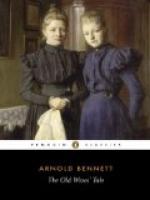The Chief Constable was not the only individual enlisted by Mr. Critchlow in the service of his friend’s fame. Mr. Critchlow spent hours in recalling the principal citizens to a due sense of John Baines’s past greatness. He was determined that his treasured toy should vanish underground with due pomp, and he left nothing undone to that end. He went over to Hanbridge on the still wonderful horse-car, and saw the editor-proprietor of the Staffordshire Signal (then a two-penny weekly with no thought of Football editions), and on the very day of the funeral the Signal came out with a long and eloquent biography of John Baines. This biography, giving details of his public life, definitely restored him to his legitimate position in the civic memory as an ex-chief bailiff, an ex-chairman of the Burial Board, and of the Five Towns Association for the Advancement of Useful Knowledge, and also as a “prime mover” in the local Turnpike Act, in the negotiations for the new Town Hall, and in the Corinthian facade of the Wesleyan Chapel; it narrated the anecdote of his courageous speech from the portico of the Shambles during the riots of 1848, and it did not omit a eulogy of his steady adherence to the wise old English maxims of commerce and his avoidance of dangerous modern methods. Even in the sixties the modern had reared its shameless head. The panegyric closed with an appreciation of the dead man’s fortitude in the terrible affliction with which a divine providence had seen fit to try him; and finally the Signal uttered its absolute conviction that his native town would raise a cenotaph to his honour. Mr. Critchlow, being unfamiliar with the word “cenotaph,” consulted Worcester’s Dictionary, and when he found that it meant “a sepulchral monument to one who is buried elsewhere,” he was as pleased with the Signal’s language as with the idea, and decided that a cenotaph should come to pass.
The house and shop were transformed into a hive of preparation for the funeral. All was changed. Mr. Povey kindly slept for three nights on the parlour sofa, in order that Mrs. Baines might have his room. The funeral grew into an obsession, for multitudinous things had to be performed and done sumptuously and in strict accordance with precedent. There were the family mourning, the funeral repast, the choice of the text on the memorial card, the composition of the legend on the coffin, the legal arrangements, the letters to relations, the selection of guests, and the questions of bell-ringing, hearse, plumes, number of horses, and grave-digging. Nobody had




